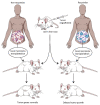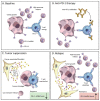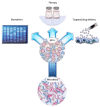Microbiota and Extracellular Vesicles in Anti-PD-1/PD-L1 Therapy
- PMID: 36291904
- PMCID: PMC9600290
- DOI: 10.3390/cancers14205121
Microbiota and Extracellular Vesicles in Anti-PD-1/PD-L1 Therapy
Abstract
Cancer is a deadly disease worldwide. In light of the requisite of convincing therapeutic methods for cancer, immune checkpoint inhibition methods such as anti-PD-1/PD-L1 therapy appear promising. Human microbiota have been exhibited to regulate susceptibility to cancer as well as the response to anti-PD-1/PD-L1 therapy. However, the probable contribution of bacterial extracellular vesicles (bEVs) in cancer pathophysiology and treatment has not been investigated much. bEVs illustrate the ability to cross physiological barriers, assemble around the tumor cells, and likely modify the tumor microenvironment (EVs). This systematic review emphasizes the correlation between cancer-associated extracellular vesicles, particularly bEVs and the efficacy of anti-PD-1/PD-L1 therapy. The clinical and pharmacological prospective of bEVs in revamping the contemporary treatments for cancer has been further discussed.
Keywords: anti-PD therapy; cancer; extracellular vesicles; microbiota.
Conflict of interest statement
The authors declare no conflict of interest.
Figures






References
-
- Global Health Estimates: Leading Causes of Death. [(accessed on 21 July 2022)]. Available online: https://www.who.int/data/gho/data/themes/mortality-and-global-health-est....
-
- Comparative Oncology-PubMed. [(accessed on 21 July 2022)]; Available online: https://pubmed.ncbi.nlm.nih.gov/20806453/
Publication types
LinkOut - more resources
Full Text Sources
Research Materials

